You can create an aesthetically pleasing image by using any of the photo composition techniques. Radial balance in photography is one such composition technique that you can use to compose your images.
But, to use this technique, you need to know what radial balance is all about. It is not only used in photography but also in other art forms like paintings, sculptures, etc.
I have used this technique to compose many of my images.
In this guide, I will show you how to use the radial balance in photography composition.
What is Radial Balance?

Radial balance is a kind of balance used in visual arts, painting, and photography.
When you use the radial balance in a design, the various elements in the design will appear as coming from a central point.
There are many types of balances in photography, radial balance is one among them.
In this type of visual balance, the elements in the photograph appear to radiate from the central point in the frame.
Many feel that for an image to be radially balanced, it needs to follow perfect symmetry. But it is not true. Perfect symmetry is not mandatory for an image following radial balance composition.
Radial Balance Explained with an Example
To make the concept clear, I will explain it in detail with the help of an example.

This flower with pink petals is a great example of an image composed using the radial balance rule.
Here, the center part of the flower acts as the central point of the frame. The flower petals act as the elements radiating outside the frame.
This frame is possible only if you make the front of your camera face the flower in a parallel fashion.
If you capture the flower petals from any other vantage point, the impact will be different and it will not follow the radial balance rule.
The low key photography technique in this image along with the pink-colored petals of the flower makes the composition even more powerful.
Radial Balance Vs Radial Symmetry – Are Both the Same?
Radial balance and radial symmetry are not exactly the same. But there are some similarities.
An image that follows radial symmetry will also follow radial balance.
But an image that follows radial balance, may not follow radial symmetry.
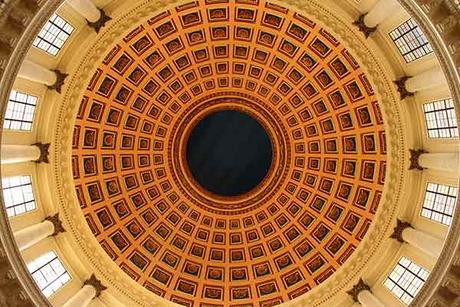
The above picture is a great example of an image that follows both radial balance and radial symmetry.
Whenever you use radial symmetry in photography, the center part of the picture will coincide with the central part of the scene and elements radiate from here.
In the case of radial balance, the central part of the scene need not coincide with the center of the picture.
Now, you know the difference between these two terms.
How to Use Radial Balance in Photography Composition?
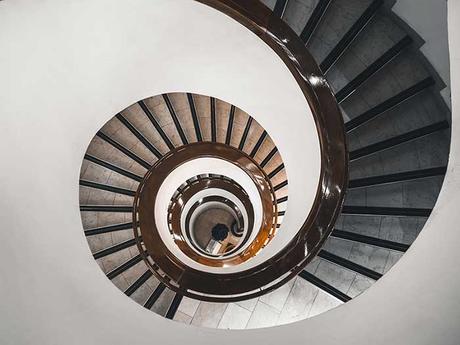
Now, I will show you how to use the radial balance to compose your images.
You cannot use it for all types of scenes. It is only suited for certain scenes.
The first thing that you need to do is to check for circular elements in the scene. Here, your observation skills matter.
Sometimes, you may not be able to find a circular pattern directly with your naked eye.
In such a situation, you can also use the telephoto focal length of your camera to see a close-up view of different elements in the scene.
If you find a pattern that follows the radial balance in design, you can compose and capture that image.
Where to Find Radial Balance?
If you are a beginner, you may find it difficult to spot the various radial balance opportunities. Don’t worry. I will share some of the commonly seen radial patterns that you can come across while doing different types of photography.
1. Architecture Photography
If you are into architecture photography, you will definitely come across many scenes where you can apply the radial balance rule for image composition.
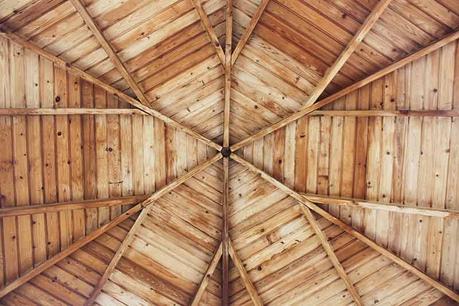
When you are inside any building look for the top ceiling and the walls for circular patterns.
Sometimes, you might be able to see circular designs on the floor too.
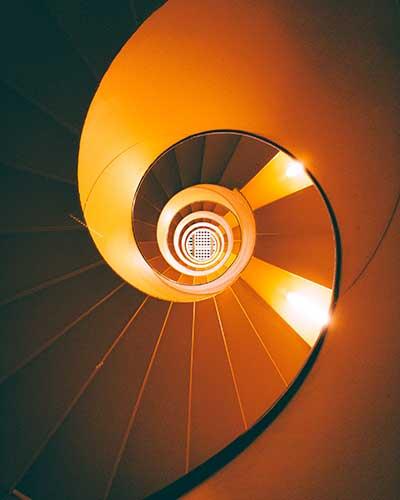
If there are staircases in the building, try to get to the top of the stairs and have a look towards the bottom.
You can see the pattern created by the staircase. It can be a spiral one at times. You can use this spiral pattern to create a compelling image with the help of radial balance.
2. Macro Photography

If you are into macro photography, try to get close to a flower to shoot a close-up of the flower. You will be able to see the circular pattern here.
When you photograph insects, frogs, snakes, or other creatures using a macro lens, you can check for circular patterns on their skin. Some insects do come with such patterns.
Also, when you capture closeup images of a human eye, you can see the radial patterns in the eye.
3. Astro Photography
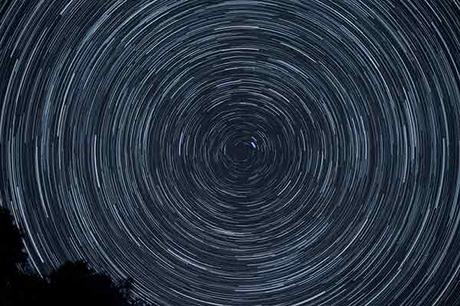
You can use this composition technique for astrophotography too. It is possible when you shoot the star trails.
It is also a great opportunity to bring both radial balance and radial symmetry in the same image.
4. Long Exposure Night Photography
When you use artificial lights for long exposure night photography, you can bring the radial/ circular pattern using these lights.
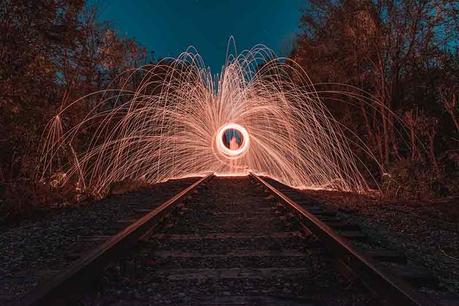
If you are doing steel wool photography, you will get the radial pattern naturally with the swinging of lit-up steel wool.
5. Portrait Photography
It will be a little difficult to use this rule for portrait photography. But you can artificially create such with the help of certain objects in the scene.
You can use a tunnel and make the person look toward the camera from the other side of the tunnel.
Some buildings do have circular openings that can help to compose a portrait image using this rule.
6. Wildlife Photography
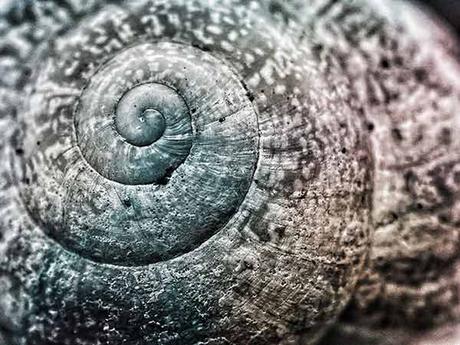
When it comes to wildlife, I have seen the spiral and circular patterns in the tails of various animals.
But it will be a little difficult to get the perfect radial composition here. You cannot make the animal pose for you.
If you encounter a chameleon, look for its tail. You might be able to see the spiral pattern here. You can also see the spiral pattern in the snail shell.
When Elephant rolls its trunk, it will be in the radial spiral pattern.
Tips to Perfect the Radial Balance Composition Technique 

I will share some useful tips that will definitely help to perfect this composition technique.
1. Use a Tripod
I strongly recommend using a tripod for your shots when you use this composition rule.
If you shoot handheld, the alignment of the image with the central point may not be perfect. So, you may end up cropping and straightening the image.
Here, there is a chance that you may end up cropping off some important elements in your frame.
2. Use Grids in the Camera
You can perfect your composition using this rule by enabling the grids in your camera.
It will act as a guiding line for aligning the center of the scene perfectly.
3. Shoot From the Right Vantage Point
You need to ensure to photograph the scene from the correct vantage point to get the perfect radial balance in your image.
You can view the scene through your camera from different vantage points and see which is best for the image.
4. Radial Blur By Intentional Camera Movement
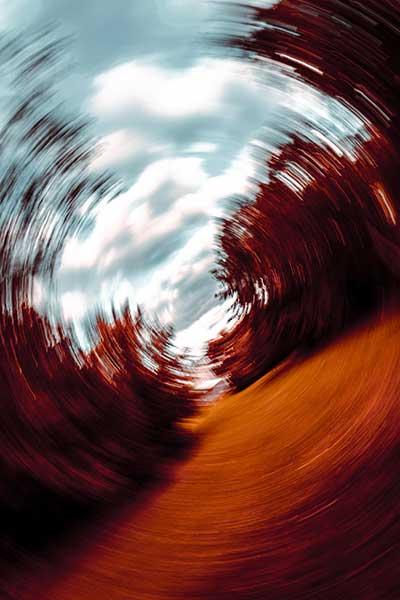
It is also possible to create this type of balance through Intentional Camera Movement (ICM).
There are two ways of doing it. In both cases, you need to use a slow shutter speed.
You can zoom in or zoom out the camera lens instantly after pressing the shutter trigger button. It will help to create the spiral pattern that follows the radial pattern.
Otherwise, you can turn the camera around its axis after pressing the shutter button.
Final Thoughts
Now you know how to compose pictures using radial balance. Don’t force this rule on all your images. Use it only for scenes where it is meaningful.

